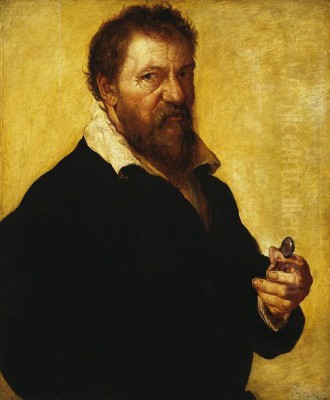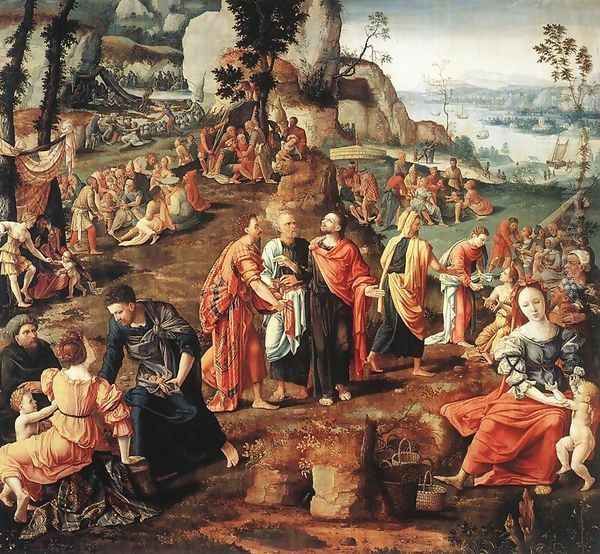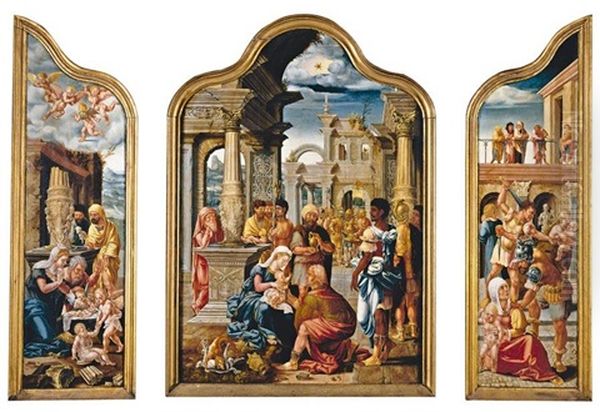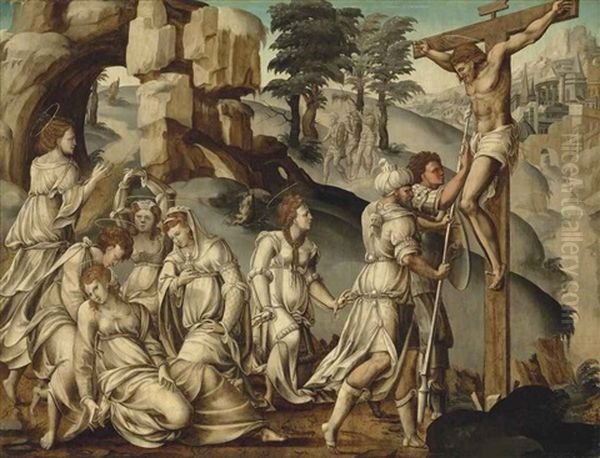
Lambert Lombard (c. 1505/1506–1566) stands as a pivotal yet often underappreciated figure in the Northern Renaissance. A native of Liège, a prominent city within the Prince-Bishopric of Liège (in modern-day Belgium), Lombard was a true polymath: a painter, architect, draughtsman, archaeologist, collector, and influential art theorist. His career marks a significant moment in the transmission of Italian Renaissance ideals to the Low Countries, and his intellectual approach to art-making left a lasting legacy, particularly through his many students.
Early Life and Artistic Formation in Liège
Born around 1505 or 1506 in Liège, Lambert Lombard's early life and training are not extensively documented, a commonality for many artists of his era. However, it is understood that he received his initial artistic education in the Low Countries, likely in Liège or possibly Antwerp, which was rapidly becoming a major artistic hub. The artistic environment of the Southern Netherlands at this time was rich, with established traditions of oil painting characterized by meticulous detail and a burgeoning interest in the human form and classical antiquity, partly inspired by earlier Netherlandish artists like Jan Gossaert (also known as Mabuse), who had himself travelled to Italy.
By 1532, Lombard's talents were recognized, as he was appointed court painter and architect to Érard de la Marck, the powerful and cultured Prince-Bishop of Liège. This position provided him with stability, prestige, and crucial opportunities for artistic development and patronage. De la Marck was a significant patron of the arts and was keen on modernizing Liège, both architecturally and culturally, in line with Renaissance ideals. Lombard's role would have involved a variety of tasks, from portraiture and religious commissions to designs for buildings and decorations.
The Transformative Journey to Italy
A defining moment in Lombard's career, and indeed for the trajectory of Renaissance art in Liège, was his journey to Italy. In 1537, Prince-Bishop Érard de la Marck dispatched Lombard to Rome. His mission was twofold: to acquire works of art for the Prince-Bishop's collection and, more importantly, to immerse himself in the art and architecture of the Italian Renaissance, particularly the works of masters like Michelangelo, Raphael, and the classical antiquities that so profoundly inspired them.

During his time in Italy, which lasted approximately a year, Lombard diligently studied and sketched ancient Roman sculptures and architecture, as well as the works of contemporary Italian masters. He is known to have met Giorgio Vasari, the famed painter and art historian, in Rome. This encounter, and his broader Italian experience, exposed Lombard directly to the theoretical underpinnings of Italian art, including concepts of proportion, perspective, and the idealization of the human form based on classical models. He also accompanied the English Cardinal Reginald Pole on part of his Italian travels, further expanding his network and intellectual horizons. This period was crucial in shaping his artistic vision and his conviction that art was an intellectual pursuit, not merely a craft.
Artistic Style: A Synthesis of North and South
Upon his return to Liège around 1538, Lombard brought with him not only sketches and possibly artworks but also a new artistic philosophy. His style became a fascinating, though sometimes critiqued, synthesis of his Northern training and the Italianate ideals he had absorbed. While he retained some of the meticulousness and rich coloration characteristic of Netherlandish painting, he increasingly incorporated classical motifs, idealized figures, and a more monumental approach to composition learned from Italian art.
His figures often display a strong anatomical understanding, though sometimes with a certain academic coolness or stiffness, a trait noted by some critics who felt his intellectualism occasionally overshadowed emotional warmth. His draperies became more complex and sculptural, echoing classical statuary and the High Renaissance masters. Lombard was a key figure among the "Romanists," Northern artists who travelled to Rome and sought to emulate Italian art. Other notable Romanists who helped transform Netherlandish art include Jan van Scorel and Marten van Heemskerck, who were slightly earlier, and his own pupil Frans Floris.
Lombard's approach was distinct. He was less interested in merely copying Italianate forms and more focused on understanding and disseminating the principles behind them. This intellectual rigor is a hallmark of his work and his teaching.
Key Works and Thematic Concerns
While many of Lombard's paintings have been lost or their attribution debated, several key works illustrate his artistic concerns and stylistic development.
The Miracle of the Loaves and Fishes: This painting, now in the Royal Museums of Fine Arts of Belgium, Brussels, is often cited as one of his most important surviving works. It showcases his ability to handle complex multi-figure compositions, a hallmark of Italian history painting. The figures are arranged in dynamic groups, and the drapery is rendered with a sculptural quality that clearly reflects his study of classical and Renaissance models. The influence of ancient Greek art has been noted in the forms and complex folds of the garments. The work demonstrates his ambition to create grand, narrative scenes in the Italian manner.

Eight Women Sacrificing to Priapus in the 16th Century: This work, known through various versions and drawings, highlights Lombard's interest in mythological and classical themes, a direct influence from his Italian sojourn. The subject matter itself, depicting a pagan ritual, was a departure from the predominantly religious themes of earlier Northern art and reflects the Renaissance fascination with antiquity. The composition and the idealized, somewhat statuesque figures are characteristic of his Romanist style.
Self-Portrait (or Portrait of Lambert Lombard): Several portraits attributed to Lombard or his circle exist. One notable example, sometimes identified as a self-portrait or a portrait by a close follower, presents the sitter with a direct, intelligent gaze. Such portraits often emphasize the sitter's intellectual status, aligning with the humanist ideal of the artist as a learned individual. The warm, yellowish background in some of these portraits is a departure from the often darker or gilded backgrounds of earlier Netherlandish portraiture and has been linked to humanist concepts of friendship and intimacy.
Religious Works and Altarpieces: Lombard executed numerous religious commissions, including altarpieces. The St. Denis Altarpiece for the Church of St. Denis in Liège (parts of which survive) is an example of his efforts to introduce a more classical, monumental style into religious art in the North. His religious scenes often feature carefully constructed compositions and figures that, while idealized, aim to convey the narrative with clarity and dignity.
His drawings are also highly regarded, often revealing his working process and his deep engagement with anatomical study and classical forms. Many of these drawings were preparatory studies for paintings or served as models for his students.
Lombard as an Architect
Beyond painting, Lambert Lombard was active as an architect, a role often intertwined with that of a court artist during the Renaissance. His architectural work was heavily influenced by Italian Renaissance principles, particularly the writings of Vitruvius and the examples he had seen in Rome. He sought to introduce classical order, symmetry, and proportion into the architecture of Liège.

One of his most significant architectural achievements was the design of the Hôtel de Cortenbach (also known as the Hôtel de Torrentius) in Liège. This building, though altered over time, showcased Renaissance elements such as classical pilasters, pediments, and a harmonious facade, representing a clear break from the prevailing Gothic style. He was also involved in designs for parts of the Prince-Bishop's Palace in Liège and other civic and religious structures. His architectural endeavors were part of a broader effort, encouraged by patrons like Érard de la Marck, to transform Liège into a modern Renaissance city.
Lombard as a Theorist and Educator: The School of Liège
Perhaps one of Lombard's most enduring contributions was his role as an art theorist and educator. Upon his return from Italy, he established an influential academy or workshop in Liège, which became a significant center for artistic training in the region. His teaching methods were innovative for the North, emphasizing the study of classical antiquity, anatomy, perspective, and art theory, much like the academies that were beginning to form in Italy (though perhaps less formally structured than later institutions like the Accademia del Disegno founded by Vasari in Florence).
Lombard believed that artists should be learned individuals, well-versed in history, literature, and philosophy, not just skilled craftsmen. This humanist conception of the artist was central to his teaching. He reportedly wrote treatises on art and architecture, though these have unfortunately not survived. His ideas, however, were transmitted through his numerous pupils, who went on to become prominent artists themselves.
Among his most famous students were:
Frans Floris (c. 1519–1570): Arguably Lombard's most celebrated pupil, Floris became a leading figure of Romanism in Antwerp. He further developed the Italianate style, creating large-scale mythological and religious paintings that were highly influential. He, in turn, ran a large and successful workshop in Antwerp, disseminating these ideals more broadly.
Willem Key (Guillaume Key) (c. 1515–1568): Another important painter who studied with Lombard, Key was known for his portraits and religious works, also active primarily in Antwerp.
Domenicus Lampsonius (1532–1599): While also a painter, Lampsonius is best known as a humanist scholar, poet, and art theorist. He was a devoted pupil and secretary to Lombard and later wrote a biography of his master, Lamberti Lombardi Apvd Ebvrones Pictoris Celeberrimi Vita (The Life of Lambert Lombard, Celebrated Painter of Liège), published in 1565, a year before Lombard's death. This biography is a crucial source of information about Lombard's life, ideas, and his circle. It is also one of the earliest examples of art historical writing in the Netherlands, predating Karel van Mander's Schilder-boeck (Book of Painters) of 1604.
Other pupils included Hubert Goltzius, a painter, numismatist, and printer, and Lambert Suavius, an engraver who helped disseminate Lombard's designs. Through these students, Lombard's influence extended far beyond Liège, particularly to Antwerp, which was then the dominant artistic center in the Low Countries.
Lombard as an Antiquarian and Scholar: The Fascination with Antiquity
Lombard's intellectual curiosity extended to archaeology and the study of ancient civilizations. He was a keen collector of antiquities, including coins and medals, and his knowledge of classical art and architecture was profound. This antiquarian interest was not merely academic; it directly informed his artistic practice. He believed that a deep understanding of classical art was essential for contemporary artists seeking to achieve excellence.
His interest even extended to Egyptian hieroglyphs and symbols, which he sometimes incorporated into his works with moralizing interpretations. For instance, in his drawing Joachim's Offering (c. 1560), he included Egyptian symbols accompanied by Italian annotations, attempting to link them to Christian allegories. This reflects a broader Renaissance fascination with esoteric knowledge and the search for universal truths in ancient cultures, a trend also seen in the work of figures like Albrecht Dürer, who explored proportion and humanist theory. Lombard's scholarly approach to art, including his study of ancient Carthaginian art and architecture, further solidified his reputation as a "pictor doctus" or learned painter.
Relationships with Contemporaries
Lambert Lombard operated within a network of patrons, artists, and intellectuals. His primary patron was Érard de la Marck, whose support was instrumental in his career and his transformative Italian journey. He also interacted with Cardinal Reginald Pole, an English humanist and churchman, during his time in Italy.
His meeting with Giorgio Vasari in Rome is significant, connecting him directly with one of the leading figures of the Italian Renaissance art world and its chief chronicler. While direct collaborations with major Italian artists are not documented, his engagement with their work was profound.
In the Low Countries, his relationship with his pupils, especially Frans Floris, Willem Key, and Domenicus Lampsonius, was paramount. These artists were not just students but also collaborators and carriers of his artistic vision. While Floris became more famous and commercially successful in Antwerp, his artistic foundations were laid in Lombard's Liège studio.
Comparisons can be drawn with other Northern Romanists like Jan Gossaert, Jan van Scorel, and Marten van Heemskerck. While all shared an interest in Italian art and classical antiquity, Lombard's approach was perhaps more systematically theoretical and pedagogical. He was less a direct contemporary of artists like Quentin Matsys, who represented an earlier generation in Antwerp, or Pieter Bruegel the Elder, whose focus was very different, though Bruegel also travelled to Italy. Lombard's specific competitive relationships are not well-documented, but the art world of the 16th century was inherently competitive, with artists vying for commissions and prestige. The mention of his descendant, George Lambert, being considered a rival to the French landscape painter Claude Lorrain by William Hogarth, though centuries later, hints at a lineage of artistic ambition.
Legacy and Art Historical Significance
Lambert Lombard's importance in art history is multifaceted. He was a crucial conduit for the transmission of Italian High Renaissance ideals – its forms, theories, and the humanist concept of the artist – to the Low Countries, particularly to the region of Liège. While his own painted oeuvre may not have achieved the widespread fame of some of his Italian contemporaries or even his own pupil Frans Floris, his intellectual impact was profound.
His school in Liège was a pioneering institution in Northern Europe, fostering a new generation of artists equipped with a more theoretical and classical understanding of art. Through his students, his influence permeated the Antwerp school, which became the dominant force in Netherlandish art in the latter half of the 16th century.
Domenicus Lampsonius's biography, Vita Lamberti Lombardi, played a vital role in shaping Lombard's posthumous reputation and in contributing to the development of art historical writing in the Netherlands. It presented Lombard as an exemplary learned artist, a model for others to emulate. Although this biography was somewhat overlooked for centuries, its rediscovery in the 20th century helped to re-evaluate Lombard's significance.
While some art historians have characterized Lombard's art as "cold" or "academic," reflecting a perhaps overly intellectualized fusion of Northern and Italian elements that didn't always achieve a seamless synthesis, his contribution to raising the intellectual status of the artist in the North is undeniable. He championed the idea that art was a liberal art, requiring not just manual skill but also profound knowledge and intellectual discipline. His work as an architect also contributed to the dissemination of Renaissance architectural principles in his native region.
Conclusion: The Learned Painter of Liège
Lambert Lombard was more than just a painter; he was a Renaissance man in the truest sense. His endeavors as an architect, theorist, educator, and antiquarian were all interconnected, driven by a deep intellectual curiosity and a desire to elevate the art of his time and place. By bringing the spirit of the Italian Renaissance to Liège and instilling its principles in a new generation of artists, he played a crucial role in the cultural transformations of 16th-century Northern Europe. Though his name may not be as universally recognized as some of his contemporaries, his influence on the development of Netherlandish art and art theory was substantial and enduring, marking him as a key figure in the Northern Renaissance. His legacy lives on through the work of his students and in the very idea of the artist as an intellectual, a concept he passionately championed.